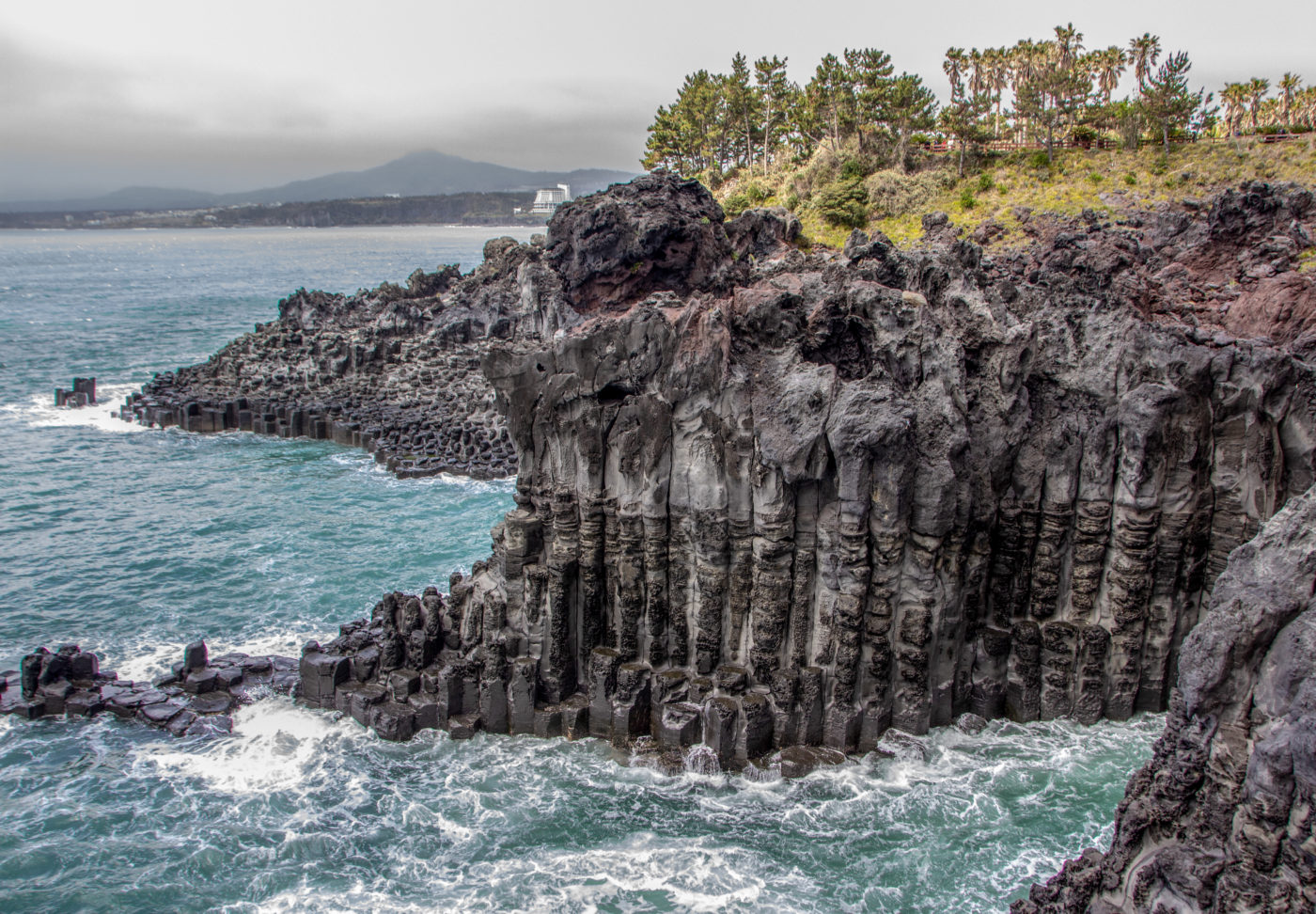Exploring Jeju Island’s top attractions reveals why it’s called “Honeymoon Island.” This subtropical area is a romantic sanctuary on the Korean Strait. Formed by volcanic eruptions 2 million years ago, this terrain sculpted into a wild, volcanic landscape of basalt and lava. Moreover, it’s balanced by colorful flowers and gardens, amidst the rocky shores and extinct volcanoes throughout the island. Here, I explored waterfalls, gardens, a Buddhist temple and the intriguing basalt landscapes along the coast.
Jeju Island’s Top Attractions
First, when we left Jeju City on the 1-hour bus ride to the southern part of the island, it was a dreary, cold and rainy day. However, as we drove further south, everything got sunnier and warmer. It ended up being a good plan, as the sun came out for the rest of our day, while it rained all day in Jeju City.
Yeomiji Botanical Gardens
Our first stop was at the island’s largest botanical garden, Yeomiji, with both lavish indoor and outdoor gardens. Inside, I walked into a vast, colorful atrium. Overall, it displays more than 2000 rare tropical and subtropical plants. Also, I climbed to the observation platform at 38 meters high to see the Hallasan Mountains.
I enjoyed most of my time outside strolling through the different cultural gardens. These segments cultivated into unique sanctuaries, according to the cultural design. For example, I explored Korean, Japanese, Italian and French gardens. This is the first botanical garden where I was able to explore different ethnic gardens all in one complex.
Overall, it was inspiring to compare the elegance and beauty of this natural landscape artistry, according to different nationalities. Other gardens that I did not have time to explore are the following: Herb, Bog, Flower, Aquatic, Cactus, Jungle, and Tropical Fruits.
Cheoinjeyon Falls
Jeju Island’s Top Attractions
Near the botanical garden, we walked down into a ravine to see the enchanting Cheoinjeyon Falls. An evergreen forest surrounds the falls, covering 2 sides of a valley. Furthermore, this habitat thrives with the whisk fern, considered the most precious plant in the province. Also, there are diverse species of climbing plants. The beautiful 3-tiered falls is the setting for the local legend about the fairies.
As the story goes, they descend from heaven to bathe here at night. Then, we go to the vast Seonimgyo Bridge, an arch bridge over Cheonjeyeon Falls. Its design depicts 7 nymphs on both sides, according to the tale of Cheonjeyeon at 128 meters in length and 78 metres high.
Daepo Jusangjeolli Cliff / Columnar Joints
Next, the mysterious coastal land formations called Columnar Joints of Daepo Jusangjeolli Cliff are the highlight of the day! This phenomenon shapes lava into hexagonal formed columnar joints from the contraction of molten lava while cooling. Moreover, these formed on Jeju Island’s southern coast about 140,000-250,000 years ago, stretching for almost 2 km.
The view is magnificent along the walkway that takes you out into the middle of the majestic maelstrom of Mother Nature. Mysteriously the jet black steep columnar joints, brace as a unique type of sea cliff against the tumultuous, turquoise waters crashing into the basalt walls. It’s exhilarating to be there, amidst the unique display of volcanic landscapes. Also, the fresh air and water ions cleanse my mind and body of stress. Loved every moment of being here for rejuvenation!!
Yakchunsa Temple
Lastly, we went to the modern Buddhist temple called Yakchunsa Temple built by a Buddhist monk in 1981. While it is famous for housing 80,000 Buddha statues in glass, for me the highlight was its landscape. At the temple’s entrance are a set of stone statues called Dol Hareubangs. They greet, as an island symbol of Gods, offering protection against demons and promoting fertility.
I walk through the entrance under a kaleidoscope of paper lanterns. I ditch the tour group and just wander outside in the beautiful gardens. South Korean temples are renowned for their stunning landscapes and I got to explore this at 2 other Korean temples. In March, the bright, botanical bliss surrounds Yakchunsa Temple.
For example, I saw tangerine orchards (the island’s trademark), golden canola fields, pink cherry blossoms, and roses among lush green foliage. Lastly, I meander through their gardens take in the aromatic journey through nature’s palette for an absolutely exquisite ending to my day in South Jeju Island.
Overall, Jeju Island’s Top Attractions
Making our 1-hour journey back, the skies slowly became grayer with cloud coverage. Upon arrival in Jeju City, we discover that it has rained most of the day. Here, I learned a valuable lesson about the different micro-climates on this small island. Overall, this stunning island of volcanic landscapes and gardens offers unique natural beauty for a life-changing experience.
Read More!
Magnificent Buddhist Temples near Busan at Haedong Yonggungsa & Beomeosa
Unique Jeju Island’s Spirited Garden & Glass Castle Theme Park Tours









